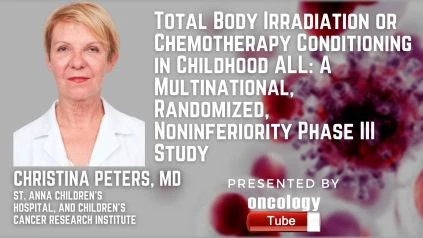Christina Peters, MD, Professor of Paediatrics of St. Anna Children’s Hospital, and the Children’s Cancer Research Institute speaks about Total Body Irradiation or Chemotherapy Conditioning in Childhood ALL: A Multinational, Randomized, Noninferiority Phase III Study.
ABSTRACT –
PURPOSITY:
In pediatric patients with acute lymphoblastic leukemia (ALL), total body irradiation (TBI) prior to allogeneic hematopoietic stem cell transplantation (HSCT) is successful, but long-term side effects are significant. We investigated whether, in such patients, preparatory combination chemotherapy could replace TBI.
METHODS AND PATIENTS:
FORUM is a non-inferiority, randomized, controlled, open-label, worldwide, multicenter, phase III sample. Myeloablative conditioning with fractionated 12 Gy TBI and etoposide versus fludarabine, thiotepa, and either busulfan or treosulfan was randomly allocated to patients aged 18 years at diagnosis, 4-21 years at HSCT, in full remission pre-HSCT, and with an HLA-compatible associated or unrelated donor. The margin of noninferiority was 8% . With 1,000 randomly allocated patients over 5 years, 2-year minimum follow-up, and 5 percent one-sided alpha, 80 percent power was assessed. If chemoconditioning was significantly inferior to TBI, futility stopping rule would stop random assignment if (EudraCT: 2012-003032-22; ClinicalTrials.gov: NCT01949129).
RESULTATIONS:
543 patients were screened between April 2013 and December 2018, 417 were randomly selected, 212 received TBI, and 201 were chemo-conditioned. On March 31, 2019, the stopping law was enforced. The median period of follow-up was 2.1 years. 2-year overall survival (OS) was substantially higher in the intention-to-treat population following TBI (0.91; 95 percent CI, 0.86 to 0.95; P < .0001) versus chemoconditioning (0.91; 95 percent CI, 0.86 to 0.95; P < 0001) (0.75; 95 percent CI, 0.67 to 0.81). The two-year combined frequency of relapse and treatment-related mortality after chemoconditioning was 0.12 (95% CI, 0.08 to 0.17; P < .0001) and 0.02 (95% CI, < 0.01 to 0.05; P = .0269) after TBI and 0.33 (95% CI, 0.25 to 0.40) and 0.09 (95% CI, 0.05 to 0.14).

